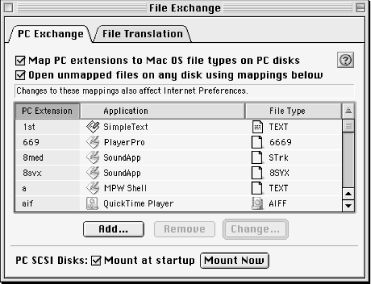Chapter 24. File Exchange Control Panel
At some time or another, every Mac
user has dealt with files that they inherited over a network from a
PC or Unix OS and then cannot open in any of their applications. A
simple example is the familiar .html files that
a web developer grabs over a network to work on (basically, text
files that can be viewed in a browser). They appear on the desktop as
a featureless icon and cannot be opened from the
browser's File menu. This is because these files
have no Mac file type or creator type that the Mac OS can identify
them with. The File Exchange control panel was designed to deal with
these frustrating situations. You can do two things with this
application:
Map a file extension like .htm or
.html to a particular Mac OS creator type and
file type, so that whenever files with these extensions are
downloaded the Mac OS knows what to do with them. In File Exchange
parlance this process is called "extension
mapping." This is handled in the PC Exchange panel
of the File Exchange control panel. Map a file
type to an application (or more than one) that will be used to handle
those files. For instance, you might choose BBEdit 5.0 to deal with
the file whenever you want to handle files of type
"TEXT." This is called
"translation mapping." The File
Exchange File Translation tabbed panel handles these mappings.
Of course, all of these elements are AppleScriptable, or we would not
be wandering this path. You can create new extension mappings with
the scriptable File Exchange control panel. This capability virtually
cries out for a droplet that, for example, creates a new extension
mapping based on a file that you drag to the droplet. This is
accomplished in the Example section at the end of the chapter, which
covers Version 3.0.3 of File Exchange. You can find out the version
of your File Exchange simply by checking its
version property, as in the upcoming syntax
example. Figure 24-1 shows the PC Exchange tabbed
panel of the File Exchange app in OS 9.

|



